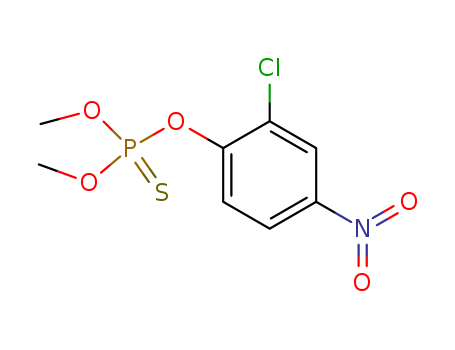- Chemical Name:Dicapthon
- CAS No.:2463-84-5
- Molecular Formula:C8H9 Cl N O5 P S
- Molecular Weight:297.656
- Hs Code.:29201900
- European Community (EC) Number:623-752-7
- UNII:6RQZ0Q90M7
- DSSTox Substance ID:DTXSID0041850
- Nikkaji Number:J6.187E
- Wikidata:Q27265392
- ChEMBL ID:CHEMBL160555
- Mol file:2463-84-5.mol
Synonyms:DICAPTHON;2463-84-5;Isochlorthion;Dicapthion;Captec;Isochlorothion;Dicaptan;Dicapton;Phosphorothioic acid, O-(2-chloro-4-nitrophenyl) O,O-dimethyl ester;Isomeric chlorthion;Phosnichlor [ISO];Isochloorthion;Isomeric clorthio;Insecticide ACC 4124;American cyanamid 4,124;OMS-214;Caswell No. 296;Experimental insecticide 4124;Isochloorthion [Dutch];ENT 17,035;AC 4124;BAY 14981;Dimethyl 2-chloronitrophenyl thiophosphate;HSDB 1564;ACC 4124;p-Nitro-o-chlorophenyl dimethyl thionophosphate;American Cyanamid 4124;ENT 17035;2-Chloro-4-nitrophenyl dimethyl phosphorothioate;EPA Pesticide Chemical Code 034502;BRN 1998406;UNII-6RQZ0Q90M7;O,O-Dimethyl O-(2-chloro-4-nitrophenyl)phosphorothioate;O,O-Dimethyl O-2-chloro-4-nitrophenyl phosphorothioate;O,O-Dimethyl-O-(2-chloro-4-nitrophenyl)thionophosphate;AI3-17035;6RQZ0Q90M7;O-(2-Chloro-4-nitrophenyl) O,O-dimethyl phosphorothioate;DTXSID0041850;OMS 214;Phenol, 2-chloro-4-nitro-, O-ester with O,O-dimethyl phosphorothioate;ENT-17035;O-(4-Cloro-3-nitro-fenil)-O,O-dimetil-monotiofosfato;O-(2-Chloro-4-nitrophenyl) O,O-dimethylphosphorothioate;O-(4-Chloor-3-nitro-fenyl)-O,O-dimethylmonothiofosfaat;O-(4-Chlor-3-nitro-phenyl)-O,O-dimethyl-monothiophosphat;O-(4-Chloor-3-nitro-fenyl)-O,O-dimethylmonothiofosfaat [Dutch];Thiophosphate de O,O-dimethyle et de O-4-chloro-3-nitrophenyle;O-(4-Chlor-3-nitro-phenyl)-O,O-dimethyl-monothiophosphat [German];O-(4-Cloro-3-nitro-fenil)-O,O-dimetil-monotiofosfato [Italian];Phosphorothioic acid O-(2-chloro-4-nitrophenyl) O,O-dimethyl ester;Thiophosphate de O,O-dimethyle et de O-4-chloro-3-nitrophenyle [French];4-06-00-01355 (Beilstein Handbook Reference);(2-chloro-4-nitrophenoxy)-dimethoxy-sulfanylidene-lambda5-phosphane;Dicapthon;Experimental Insecticide 4124;Dicaphton;DICAPTHON [MI];DICAPTHON [HSDB];SCHEMBL118674;CHEMBL160555;DTXCID8021850;Tox21_301908;BAY-14981;AKOS015903389;AKOS040744446;NCGC00255656-01;CAS-2463-84-5;LS-108467;O,O-dimethyl 2-chloro-4-nitrophenyl thiophosphate;J-015611;o-(2-Chloro-4-nitrophenyl) o,o-dimethyl thiophosphate;Q27265392;O-(2-Chloro-4-nitrophenyl) O,O-dimethyl thiophosphate #;O-2-CHLORO-4-NITROPHENYL O,O-DIMETHYL PHOSPHOROTHIOATE;(2-chloro-4-nitrophenoxy)-dimethoxy-sulfanylidene-?^{5}-phosphane







